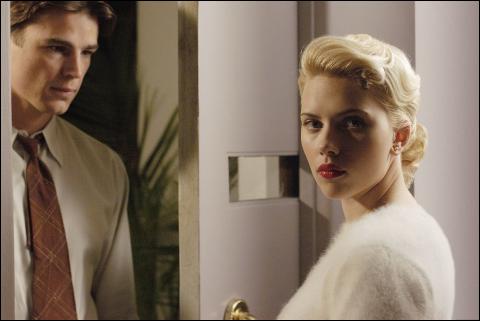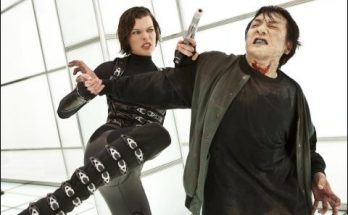Canadian actress Mia Kirshner—best known for her role as Jenny on the past two seasons of Showtime’s The L Word—had actually come in early to read for the role of the duplicitous Madeleine Linscott. De Palma was so taken with the actor’s performance that he and Friedman enhanced the scenes with the Dahlia and cast Kirshner in the film. “She’s really quite stunning,” he comments. “When I saw her test, I said, ‘Mia, I have to have you in this movie. We’re going to build up the character of the Dahlia, and I want you to play her.’”
The actor notes that “as a kid in Toronto, I used to go to the library and pull out books of old movies and look at pictures of Vivien Leigh and Hedy Lamarr. My Dad and I would watch old movies on Saturday night, and I grew up very much having a reverence for noir.”
Kirshner had heard many of the stories about the fabled actress she would play, but was keen to make up her own mind as she explored the woman who was Elizabeth Short. She felt it important to humanize the tragic Betty, believing her story a “cautionary fable for young Hollywood actresses.” Kirshner offers, “I really tried to find the essence of Elizabeth. After reading as much as I could about her, I saw a very soft, romantic, intelligent woman.”
For the role of devious and alluring Madeleine Linscott, De Palma would need an actor who not only could pull off a femme fatale, but one who favored Mia Kirshner in looks. Ellroy’s material was quite specific about the fact that the Dahlia is killed because of not who she was, but who she resembled.
Double Oscar winner Hilary Swank was fresh off her role in Clint Eastwood’s Million Dollar Baby when she signed on to play Madeleine, a woman who has no concept of the word “conscience.” De Palma, a longtime fan and purveyor of femmes fatales, wanted an actor who could handle the complicated role of “a poor little rich girl who will lead these guys right to their doom.” He says, “I think Hilary’s a classic spider woman—she can play a character who is extremely vulnerable and extremely evil at the flip of a switch.”
Of Swank’s casting, screenwriter Friedman chuckles, “If you can get someone who has won two Academy Awards® to play on-screen in your film for 25 percent of the time, it’s a dream come true for a writer.”
Kudos aside, Swank was simply thrilled she was off the grueling training regimen required to turn her into boxing champ Maggie Fitzgerald. “Madeleine would never drink egg whites for breakfast,” the actor laughs.
Swank chose the role because “Madeleine was so different from anything that I’ve ever done. She comes from high class, affluent background—slumming along and doing whatever she wants—a spoiled, Daddy’s little girl. But behind all of that, she’s a very troubled person who is actually searching for love.”
Playing mother to the pack of oddities known as the Linscott family is acclaimed British actor Fiona Shaw. The woman who fanatically shifts between snobbish clarity and operatic binges, Mrs. Linscott would need to be played by a performer who could, in a heartbeat, turn on (and off) her maddening charms.
De Palma recalls of one of the film’s signature scenes—the dinner where Bucky is introduced to the Linscott family—“Fiona would give Josh a distasteful look that says, ‘What is this policeman doing in my home?’ With her tricky exposition, she reminds me of Vanessa Redgrave. She makes the character so much fun.”
Next Page: Doppelgangers to Dioptic Cameras
Views: 54



